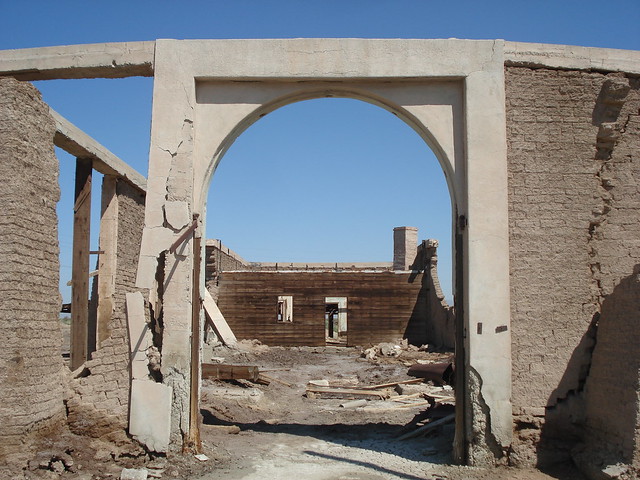This is the fifth in a series of extracts from my new book The Return of the Mullet Hunter, which I am posting over the the course of this week.
This antepenultimate extract is about the harsh landscape of the Salton Sea, in the desert of southern California, which I visited in search of Mullet Island. I’d never experienced a heat, landscape or atmosphere like it. It was shortly before visiting Salvation Mountain. The photo is of the ruined house mentioned below.
Following the increasingly rugged tracks as we got further from the main roads round the lake, we found less and less evidence of civilisation. The ground was parched and in places cracked from the sun. In the distance, pipes and chimneys from what I guessed was a desalinisation plant were among the few non-natural breaks in the horizon.
At one point we stopped the car next to what seemed to be the remains of a burnt out house. Built I think of brick and wood, some walls remained intact, tall windows suggesting this had been a place of some substance. But the charred beams and piles of debris within spoke of some unknown accident or disaster, or perhaps just the unrelenting environment defeating its inhabitants. Just like Salton Sea, which had grown to subsume human settlement, the land was similarly continuing to remind people who was boss, putting humans in their place in this big, hot, unforgiving world.
It echoed with my research into the area. Humanity struggled here, the land and — in the case of the formation of Salton Sea — even the water reclaiming everything, rust and decay pushing back people’s attempts at settlement and restoring it, almost, to its original state. Just a few clues remained as monuments to humanity’s defeat, scant evidence that settlement had even been attempted. This ruined house was one; the few others included small industrial scatterings, such as oil tanks, hauntingly lonely electricity pylons and the occasional empty shed. Life was clearly harsh here. Even just half a day’s exposure to the beating desert sun made us unequivocal in our realisation of that.
In the stifling heat, the silence was so powerful your own breath, heartbeat and footsteps were amplified. It was as if the rest of the world had disappeared. Even as we returned to the comfort of the air-conditioned car and headed back to the main road, it was hard to see evidence that humanity still existed.
We made our way to Niland, the nearest village and the only one for some distance around according to our guidebook. Empty streets greeted us, people beaten back by the midday heat, building exteriors scorched by the unrelenting sun and dust of the desert. On the main street, outside a single-storey building that appeared to have once been a small supermarket, were some noticeboards. Among the graveyard of bare, rusting staples, a handful of bizarre messages on one board gave some clues that there was life in the area.
“BIG YARD SALE”, declared one, the date of said sale a few weeks previous. “From 8 til its all Gone”.
In the opposite corner of the noticeboard was a similar notice for a sale on a different date.
One curious note read:
BIKE SKIMMER
WHEN YOU FORCE
A BICYCLIST
OFF THE ROAD HIS
BIKE CAN THROW
HIM BACK UNDER
YOUR WHEELS.
MIGHT RUPTUR
YOUR TIRE!
Another’s handwriting demonstrated a creative approach to capitalisation:
I Am LooKing For
A CloThes TruNK
iF Some one HAS ONe
I am WilliNg To Buy iT
For $20.00
Some Times I come To The
united Food CeNTer store
I drive white cAdillac
On yet another, someone who seemed to need to declare himself a US Korean War veteran was selling some tools, while other “for sale” notices included adverts for a jeep and a trailer.
It was a surreal collection of messages that did nothing to dispel the mystery of Niland. Where, on this silent day, were the people that wrote them, and who did they envisage would read them?
One of the few structures lying off the main road was a surprisingly ostentatious Grecian-columned building, maybe an old bank or theatre, lying empty and seemingly unused, the outside a portrait of peeling paint and weathered stonework. Not so much faded grandeur as faded decay.
You can buy The Return of the Mullet Hunter on the Kindle for a frankly bewildering bargain price at Amazon UK, USA, Canada and Australia, plus all other Amazon regions. Other ebook formats and a paperback version will follow in 2014.



